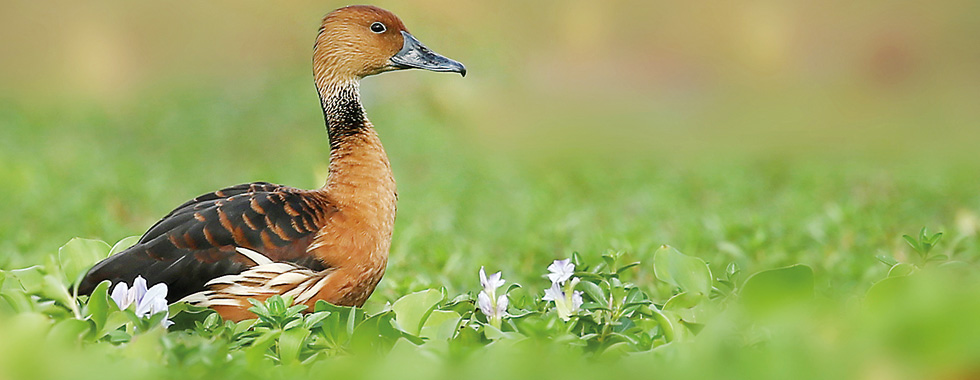A rare ‘feast’ of beautiful vagrants
Her ears confirmed what her eyes had beheld from the tank-bund in Chilaw, even as frantic calls to Colombo yielded disbelief followed by the query, “Are you sure?”

A sight to behold: Solitary Large Whistling Teal in the still, lotus-dotted waters of the Anavilundawa tank. Pic by Dr. Sudeera Bandara
Gripped by amazement, as she peered closely from the bund and heard the sound, more like ‘a shikra’s call’ at a different pitch than the usual ‘whistling’ and turned to take in the image of the sound emanating from a duck with its beak open, she was mildly distracted by her friend, Kumari.
Her friend was nudging her and mumbling about babies. But that could not be! There could be no babies. “Over the moon,” is how Tara Wikramanayake, a committee member of the Ceylon Bird Club describes her elation. It was a ‘feast’ of Large Whistling Teal (Fulvous Whistling-duck or Dendrocygna bicolor) spread before their very eyes on the morning of July 7.

Kithsiri Gunawardena
Not only were there scattered adult-pairs as well as solitary Large Whistling Teal swimming in the still, lotus-dotted waters of the Anavilundawa tank, but also seven chicks ensconced between their mother and father. This was ample proof that they are breeding in Sri Lanka.
So what, many would wonder. Why such a fuss over the sighting of ducks?
It is Ceylon Bird Club Joint Secretary Kithsiri Gunawardena who explains the significance. Dipping into history to describe terms used in bird parlance, he points out that there are ‘common’ and ‘rare’ birds among the two categories ‘residents’ and ‘migrants’.
While ‘residents’ are found throughout the year and breed in conducive locations during a particular season, ‘migrants’ would come a-visiting, leaving behind wintry climes for a certain period of time. “Sri Lanka has 456 species of birds, with 240 ‘residents’ and the balance being ‘migrants’,” says Kithsiri.
The rare birds are individuals or species that are only spotted once or twice and the rarest of migrants are dubbed ‘vagrants’, under which category has been the Large Whistling Teal. These beautiful wetland visitors have been sighted only three or four times in the past 60 years, it is learnt, and never been known to breed in Sri Lanka.

Tara Wikramanayake
Coincidentally, it was Tara herself who had seen one of these beauties back in October 1997 in the Talangama tank, while well-known environmental lawyer and bird-lover Jagath Gunawardena most probably spotted the same duck at Bellanwila around the same time.
“After that there has been no sighting of the Large Whistling Teal,” laments Kithsiri.
Soon after Tara and her friend were privy not only to the sight of the Large Whistling Teal but also to the thrill of seeing their babies, it was to text and bird books that Tara turned to, to find differing descriptions of their location in Asia. While some descriptions “placed” them in India and Pakistan, others located them as ‘rare residents’ in south Myanmar and formerly resident, with the current status being unknown, in southwest and east Myanmar. They are known to be ‘winter visitors’ to Bangladesh and Southeast Asia.
Their ‘spread’ is very wide, says Tara, pointing out that they are found in parts of Africa — south of the Sahara from Senegal across the sub-Sahara belt to Ethiopia and southwards down the entire eastern half of the African Continent to South Africa and Madagascar. Their distribution is local and somewhat discontinuous. They are also found in the tropical Americas. (See map) However, they are recorded as breeding in northeast India down to Bangladesh and towards south Myanmar, she adds.

Breeding range (Vieillot, 1816)
It was while Tara and Kumari were en-route to Anuradhapura to spend a few days that they decided to stop-by in Chilaw. Tara who had shown a fascination for birds since she was little, collecting feathers and fallen nests, had been invited, as was the norm, to join the Bird Club about 10 years ago.
The choice in Chilaw was Navadankulama or Anavilundawa tanks, with Tara pushing for the former and Kumari the latter as it was closer. Stopping the car, they walked leisurely along the tank-bund when what greeted them were the Large Whistling Teal.
Unable to believe her eyes, Tara blinked and looked once again to make sure that they were not the common Lesser Whistling Teal (Lesser Whistling-duck or Dendrocygna javanica) seen in almost all the water bodies in the country.
“They stood out,” says Tara, explaining that their colours were brighter and they had prominent white feathers on their flanks, like sails sticking out making them distinguishable from the Lesser Whistling Teal. Their markings were distinct, the black line stretching from the top of the neck to the base of the neck and their heads were a ruddy-russety colour. All in all she and Kumari saw nine adults.
The call of the Large Whistling Teal put paid to any doubts Tara may have had, for it was at a completely different pitch to the call of the Lesser Whistling Teal. “The seed of doubt was cast aside,” she laughs.
The Large Whistling Teal were “happily co-existing” with their commoner cousins, but a common coot seemed to be very angry at their presence creating a major racket, says Tara. The very next day, excited Bird Club members, Joint Secretary Deepal Warakagoda, Palitha Antony, Uditha Hettige and Chinthaka de Silva were on the spot, spending more than four hours, to take in their fill, without disturbing the Large Whistling Teal. They had been rewarded not only with 20 adults and also extensive calls which they had recorded, but one pair had even presented them with a courtship display while another pair had mated before their eyes.
All strong and healthy signs that the Large Whistling Teal intend to make Anavilundawa tank, a home away from home, to nurture their young.
| The Ceylon Bird Club The Ceylon Bird Club, a non-governmental, non-profit organization, was founded in 1943 by seven members, including G.M. Henry and W.W.A. Phillips, two of Sri Lanka’s foremost ornithologists. Initially, its object was to make a record of members’ observations. Since then, the club which has a membership of 95 currently has been active in collecting, recording and providing information on the birds of Sri Lanka, their status and distribution.Today a chief aim of the club is promoting the protection of bird species and sub-species and the conservation of their habitats in Sri Lanka. The club strives to find out which bird forms are threatened, monitors their survival and habitats and conducts surveys. The Bundala National Park, the Anavilundawa Sanctuary and the Vankalai Sanctuary were designated as such and/or Ramsar Sites mainly owing to the club’s proposal, information and persuasion.The main requirement in a member is competence and reliability in the identification of the birds of Sri Lanka, so that the accuracy and integrity of the club’s data are maintained, as it forms the basis of scientific, conservation and other important work. An affiliate applicant, meanwhile, must be recommended by a member of the club to be considered for enrolment. Affiliate status is offered to individuals with a keen interest in birds and bird-watching and who are also interested in furthering their knowledge on identifying bird species accurately in the field. First record of breeding in Sri Lanka Explaining how it can come about, Kithsiri says that if there is a disturbance in the original habitat of migratory — including vagrant — birds they look for a conducive and “safe” locality to start breeding. This is a rare situation. Therefore, it is a compliment to Sri Lanka that the Large Whistling Teal has found a secure refuge at Anavilundawa tank, a Ramsar site. The need is for people who wish to observe and photograph this rare sight of breeding Large Whistling Teal to do so unobtrusively, is the plea by the Bird Club. “Let these vagrants feel safe and secure with their young around them, so that more and more will flock to Anavilundawa tank.” |


